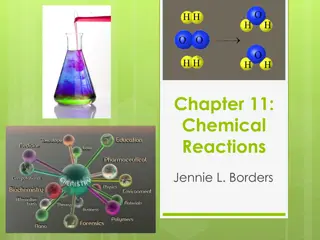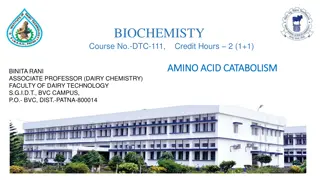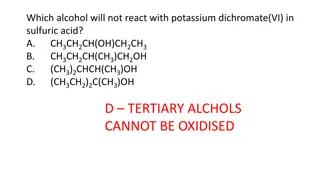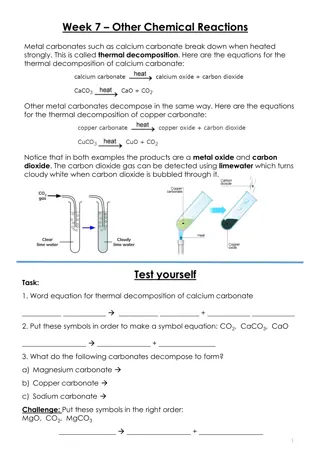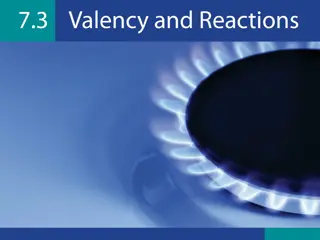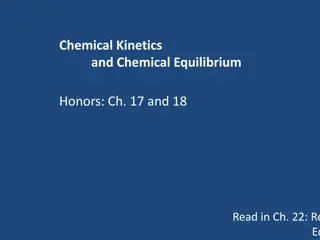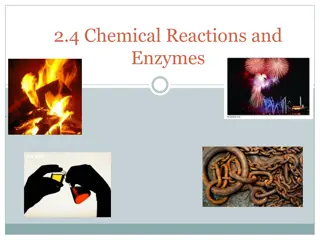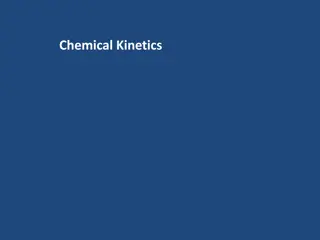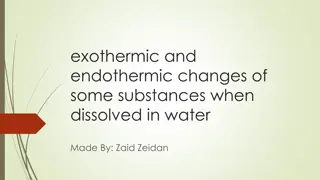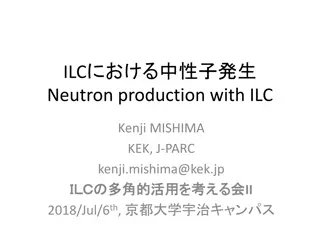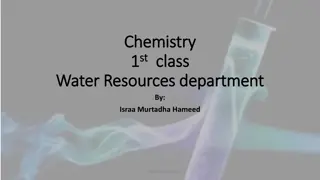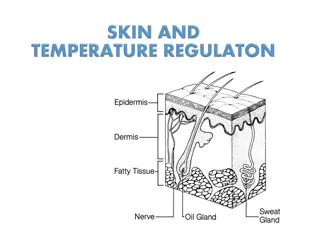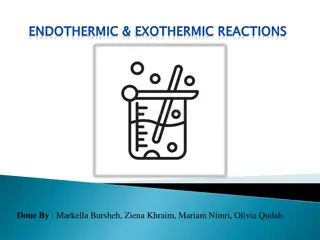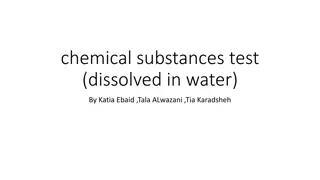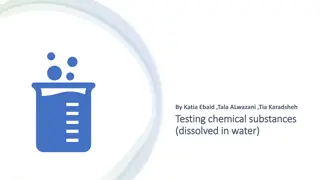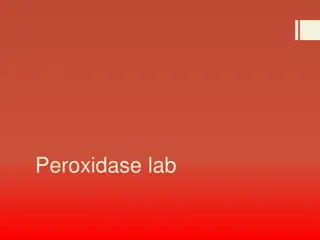Biochemical Reactions
Exploring the basics of chemical reactions, the conservation of matter principle, exothermic and endothermic reactions, and the role of activation energy in jumpstarting reactions. Learn how elements transform to create products, the significance of energy release or absorption, and the essential co
3 views • 19 slides
Overview of Serious Adverse Reactions and Transfusion Events
This data compilation covers the reporting trends, breakdown of reports, components issued, and specific types of adverse transfusion reactions experienced within the National Healthcare Organization (NHO) from 2019 to 2022. The information includes statistics on Serious Adverse Events (SAE), Seriou
2 views • 46 slides
Understanding Chemical Reactions: Key Concepts and Practice Problems
Explore the fundamental concepts of chemical reactions, including how reactants and products are represented, the role of catalysts, and writing word equations. Learn through sample and practice problems illustrating different types of reactions. Master writing chemical equations for reactions invol
1 views • 51 slides
Amino Acid Catabolism: Pathways and Reactions
Amino acid catabolism involves removing amino groups via deamination, leading to urea synthesis and TCA cycle intermediates. The process includes transamination and oxidative deamination reactions, with specific aminotransferases catalyzing these reactions. Transamination is a key step in funneling
0 views • 23 slides
Organic Chemistry Reactions Overview
This content covers various aspects of organic chemistry reactions, including the oxidation of alcohols with potassium dichromate, the solubility of molecules in water, and the oxidation of propan-1-ol to form aldehydes or carboxylic acids. It also explores the oxidation of butan-2-ol and the suitab
0 views • 9 slides
Overview of Organic Reactions and Mechanisms
Organic reactions can be categorized into addition, elimination, and substitution reactions, occurring through either polar or free radical mechanisms. Polar reactions may be electrophilic or nucleophilic, while free radical reactions involve radicals reacting to complete electron octets. Different
2 views • 26 slides
Understanding Redox Reactions in Chemistry
Salts can be prepared through redox reactions involving metals and acids. This interactive lesson covers oxidation numbers, identifying oxidized and reduced elements, and explaining electron transfer in redox reactions. Examples include reactions of aluminum with sulfuric acid and magnesium with cop
2 views • 12 slides
Exploring Enzyme Kinetics for Understanding Chemical Reactions
Enzyme kinetics is a vital discipline focusing on the rate of enzyme-catalyzed reactions and how they respond to varying conditions. Reactions are classified based on reactant concentration influences. Zero, first, second, and third order reactions are distinguished, with examples like first-order r
0 views • 31 slides
Understanding Electrochemical Processes in Materials Engineering
Electrochemical processes play a crucial role in materials engineering, specifically in the context of corrosion. These processes involve both oxidation (anodic reaction) and reduction (cathodic reaction) reactions occurring simultaneously. Maintaining a balance between these reactions is essential
3 views • 22 slides
Understanding Energy Changes in Chemical Reactions
Exothermic reactions release energy to the surroundings, exhibited in processes like respiration and combustion. On the other hand, endothermic reactions absorb energy, demonstrated in examples such as photosynthesis. By observing changes in temperature and reactions between various substances, one
0 views • 24 slides
Chemical Reactions and Energy Transfers
Understanding chemical reactions involving thermal decomposition of metal carbonates, identifying exothermic and endothermic reactions based on energy transfers, and recognizing oxidation and reduction in redox reactions.
1 views • 5 slides
Understanding Photochemical Reactions in Chemistry
Photochemistry is the study of chemical effects produced by light radiation. It involves different types of chemical reactions such as photochemical and thermal reactions, each influenced by various factors like light, temperature, and catalysts. This article explores the differences between thermoc
0 views • 17 slides
Mechanisms and Models of Nuclear Reactions
The chapter discusses the reaction cross-section in nuclear reactions, including resonance and tunneling phenomena. It explains the probability of reactions occurring, the influence of nuclear radius on cross-section, and how tunneling allows reactions at energies lower than the Coulomb barrier. Exa
0 views • 22 slides
Understanding Nuclear Reactions: A Comprehensive Overview
Nuclear reactions involve direct and compound scenarios, with direct reactions occurring in a short period and compound nucleus reactions leading to long-lived excited states. Different types of reactions like elastic scattering, break-up, and compound nuclear reactions are discussed, highlighting t
5 views • 11 slides
Understanding Electrode Reactions in Electrochemistry
Exploring electrode reactions in electrochemistry involves delving into Faraday's law, coulometry, and the importance of sustainable electrode reactions. These concepts help us understand how the quantity of charge passed affects the production or consumption of substances in electrode reactions. As
4 views • 27 slides
Energy Changes in Chemical Reactions Explained
Exothermic reactions release energy to the surroundings, examples include respiration and combustion, while endothermic reactions absorb energy, like in photosynthesis. By measuring temperature changes and observing reaction profiles, we can understand how bond-breaking and bond-making processes dri
0 views • 24 slides
Energy Changes in Chemical Reactions
Energy changes in chemical reactions can be categorized as exothermic and endothermic. Exothermic reactions release energy to the surroundings, while endothermic reactions absorb energy from the surroundings. Examples and uses of both types of reactions are provided, along with details on measuring
4 views • 24 slides
Understanding Hypersensitivity Reactions and Classification
Hypersensitivity reactions occur in sensitized hosts following contact with specific antigens, leading to injurious consequences. The Gell and Coombs Classification categorizes reactions into Type I, II, III, and IV based on immune response and duration. Type I reactions are immediate and humoral, w
0 views • 30 slides
Understanding Oxidation-Reduction Reactions in Chemistry
Explore the concept of oxidation and reduction in chemistry, which are fundamental processes that occur simultaneously in oxidation-reduction reactions. Learn about the role of oxygen, different types of oxidation reactions beyond burning, such as bleaching stains, and the concept of reduction invol
0 views • 34 slides
Understanding Chemical Bonding: Valency, Formulas, and Reactions
Explore the world of chemical bonding with this unit covering valencies, chemical formulas, ionic vs. covalent bonds, and exothermic vs. endothermic reactions. Learn to predict element combinations, create molecular formulas, and differentiate between various bond types. Jigsaw diagrams demonstrate
0 views • 46 slides
Key Fusion Reactions in Nuclear Astrophysics
Fusion reactions play a crucial role in nuclear astrophysics, with key reactions involving light elements such as Li, Be, B, and stable carbon isotopes. Understanding fusion of light heavy nuclei at extreme energies is essential for predicting stellar evolution. The S-factor provides a convenient re
0 views • 31 slides
Understanding Chemical Reaction Kinetics: From Unimolecular to Three-Body Reactions
Explore the fundamental concepts of chemical reactions, including unimolecular reactions like thermolysis and photolysis, bimolecular reactions, and three-body reactions. Learn about rate constants, reaction mechanisms, and the impact of pressure on reaction rates. Discover how energy transfer, phot
0 views • 9 slides
Understanding Mineral Reactions in Metamorphism
Mineral reactions play a crucial role in our comprehension of metamorphism, helping to estimate the pressures and temperatures rocks undergo. These reactions can be categorized as continuous or discontinuous, leading to different mineral products. Discontinuous reactions, exemplified by the transfor
0 views • 6 slides
Understanding Chemical Kinetics and Equilibrium in Reactions
Explore the basic concepts of reaction rates, collision theory, activation energy, and energy diagrams in chemical kinetics and equilibrium. Learn how particles must collide with the correct orientation and enough energy to form an unstable activated complex. Discover the role of activation energy i
0 views • 24 slides
Understanding Chemical Reactions and Catalysts
Chemical reactions involve the formation of new substances from reactants, with key processes like oxidation and reduction. Reversible reactions, endothermic and exothermic reactions, and the role of catalysts in speeding up reactions are explored. The significance of chemical symbols, formulas, and
0 views • 8 slides
Understanding Nuclear Reactions: Fission, Fusion, and Energy Release
This content covers various aspects of nuclear reactions, including nuclear fission, fusion reactions, the Manhattan Project, and examples of reactions involving different particles and elements. It explains concepts like exoergic and endoergic reactions, conservation of charge and nucleon number, a
0 views • 34 slides
Understanding Energy in Chemical Reactions
Chemical reactions involve the release or absorption of energy in various forms like heat, light, sound, and electricity. Exergonic reactions release energy, while endergonic reactions absorb energy. Catalysts speed up reactions, while inhibitors slow them down without changing the amount of reactan
0 views • 8 slides
Understanding Chemical Reactions and Enzymes
Chemical reactions involve the transformation of chemicals by breaking and forming chemical bonds. Energy is released or absorbed during these processes. Reactions that release energy are exothermic, while those that absorb energy are endothermic. Catalysts help speed up reactions by lowering the ac
0 views • 13 slides
Understanding Chemical Reactions in Daily Life
Understanding chemistry, particularly chemical reactions, is crucial for our daily lives. Chemical reactions involve the transformation of substances into different ones, described by reactants and products in equations. By learning about chemical equations, word equations, formula equations, and th
0 views • 15 slides
Understanding Chemical Kinetics: Reaction Rates and Activation Energy
Exploring the fundamental concepts of chemical kinetics, this content delves into reaction rates, collision theory, and activation energy in chemical reactions. It emphasizes the importance of particle collisions, correct orientation, and energy requirements for reactions to occur. Through energy di
0 views • 17 slides
Understanding Endothermic and Exothermic Reactions in Chemistry
Exploring endothermic and exothermic reactions, this activity involves measurements to determine heat release or absorption. Students create hypotheses and test them using Labidisc temperature sensors. Theoretical background on chemical reactions, energy absorption, and heat release is provided, ena
0 views • 20 slides
Exothermic and Endothermic Reactions of Different Substances
Learn about the concepts of exothermic and endothermic reactions, featuring specific substances like sodium hydroxide, lithium nitrate, ammonium nitrate, crystalline ammonium nitrate, and potassium bromide. Discover their properties, uses, and how they interact with water. Explore how these reaction
0 views • 5 slides
Neutron Production Reactions at ILC - Applications and Estimations
Neutron production reactions at the International Linear Collider (ILC) involving nuclear reactions, photo-nuclear reactions with light and heavy nuclei, estimation of neutron production using gamma irradiation on Be-9, and application prospects. Cross-sections, energy inputs, and conversion rates a
0 views • 29 slides
Understanding Exothermic and Endothermic Reactions in Chemistry
In chemistry, it's essential to differentiate between exothermic and endothermic reactions based on the direction of heat flow. Exothermic reactions release heat to the surroundings, while endothermic reactions absorb heat to proceed. Through examples like the combustion of propane and the formation
0 views • 21 slides
Theoretical Data Base for Rare Nuclear Reactions Using Quark-Level Model
The creation of a theoretical data base for rare nuclear reactions using the CHIPS quark-level model is discussed in this research by Mikhail Kosov and Aleksey Grachkov from Dukhov Automatics Research Institute VNIIA. The study aims to predict cross-sections of unmeasured reactions, assess neutron-n
0 views • 18 slides
Understanding Thermoregulation in Animals and Humans
Thermoregulation is the process of regulating body temperature in organisms. It can be seen in two types of animals - ectothermic and endothermic. Ectothermic animals rely on external energy sources to maintain body temperature, while endothermic animals use internal metabolic energy. The skin plays
0 views • 22 slides
Understanding Endothermic and Exothermic Reactions Through Experiment
Explore the concepts of endothermic and exothermic reactions with a detailed experiment to determine which solute dissolves most endothermically and exothermically in water. Discover the roles of heat transfer in chemical reactions using potassium chloride, calcium chloride, sodium carbonate, and so
0 views • 11 slides
Exploring Chemical Reactions: Testing Substances Dissolved in Water
Explore the fascinating world of chemical reactions by testing various substances dissolved in water. Discover how salt, sugar, baking soda, borax, and vinegar interact with water, leading to endothermic or exothermic reactions with unique properties and uses.
0 views • 6 slides
Testing Chemical Substances Dissolved in Water
Explore the effects of salt, sugar, baking soda, borax, and vinegar when dissolved in water. Discover their properties, reactions, and practical applications, shedding light on endothermic and exothermic reactions in aqueous solutions. Delve into the chemical compositions and behaviors of these comm
0 views • 6 slides
Investigating Chicken Liver Reactivity with Hydrogen Peroxide Using Peroxidase Lab
Explore the reaction between chicken liver and hydrogen peroxide in this peroxidase lab experiment. Learn about peroxidase enzymes that break down hydrogen peroxide into less harmful substances. Follow the procedure using materials like an Erlenmeyer flask, toothpick, and candle to observe reactions
0 views • 11 slides


